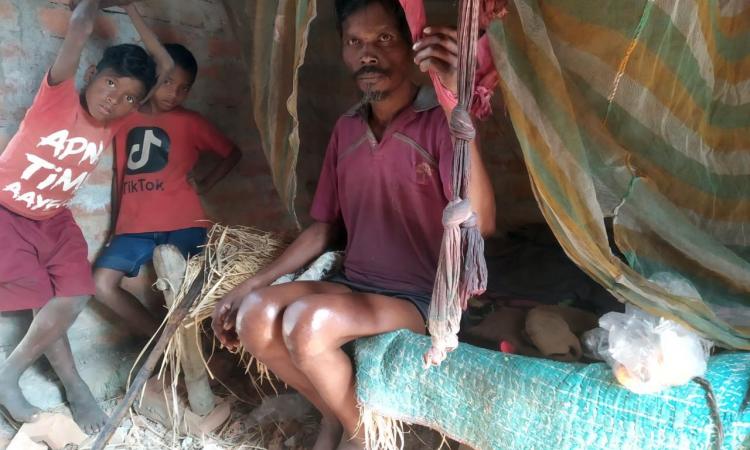
“What should I do? I have been bedridden for two years now. My hands and feet do not work. I have become a burden on my family. I cannot endure the pain and wish for death every single moment,” said 58-year-old Safal Murmu, lying on a cot in a dark corner of a crumbling hut. Although he awaits death, the desire to live a pain-free life trickles through his eyes.
Safal is not the only unfortunate person in the panchayat of Simhaldhab in Jharkhand’s Sahebganj district. 65-year-old Pahra Hembram, 62-year-old Sitaram Pandit, 60-year-old Mati Soren, 52-year-old Hopni Kisku, 50-year-old Sanjhi Murmu, 35-year-old Kanhu Murmu, 34-year-old Budhin Tudu, 30-year-old Munjhi Hansda and 28-year-old Mangal Kisku are suffering from fluorosis.
In Barhet block, water has become poisonous leading to a lethal disease called skeletal fluorosis caused by excessive accumulation of fluoride in bones. Many of the inhabitants of this village suffer from crippled bones, bent joints, and in many houses, one can find bedridden patients with multiple fractures in legs and arms. Several lives have already been lost with no solution in sight.
Despite the high mortality rate due to fluorosis in the area, there has been no documentation of the deaths caused by the disease. No one can confirm exactly how many lives have been lost to fluorosis.
As per the locals, the village has been cursed with the disease since its existence. Many generations have suffered the brutality of the disease. Of the 13 tolas in Simhaldhab panchayat in Barhet block, Pandit tola, Ilaki and Shrish tola are worst affected.
As per Deenbandhu Pandit, a resident of the village, “In 2000, a filter was installed in few of the handpumps in our village by the Public Health Engineering Department (PHED). As part of maintenance work, the filters have been changed two or three times. But nothing has been done after that. This pushed villagers to stop drinking water from handpumps. The entire village is now dependent on just one well for all their needs.
As per Geologist Dr Ranjit Kumar Singh, elements like iron, magnesium, arsenic, fluoride are found in underground water. Excess of fluoride can cause this disease. To make water fit for drinking in affected areas, one solution is to filter it. He suggests another solution of drawing water from an alternate source.
The Mega Rural Water Supply Scheme launched by the Government of Jharkhand tried to address the problem by providing water from a river nearby. Under this scheme, water from Kherwa Gumani river was to be supplied to these areas. However, the only people who have been benefitting from this scheme are the residents of Barhet Bazar. People residing in remote and most affected villages couldn’t benefit from the initiative for a long time.
In 2017, a pipeline was laid in this panchayat and villagers started receiving water from February onwards. “The relief was short-lived as by September, the water supply was discontinued. Pipes were damaged during construction of roads in the region,” informed Francis Soren, another resident of the village.
Due to lack of awareness in these tribal villages, patients suffering from fluorosis do not go to the doctor. Owing to financial constraints, they rely upon quacks and hakims to help them get rid of the pain. Some depended upon local organizations helping the villagers.
“I consulted a sister from Kundli Mission who provided me medicines for my pain. As long as the effect of medicines was there, I felt relieved,” shared Kanhu Murmu, local resident suffering from the disease.
Sharing the steps taken by the government to tackle the issue, Executive Engineer Vijay Kumar Edwin said, “The filters have been installed in the hand pumps in the fluorosis affected areas of Barhet block. Maintenance and replacement of these filters are also done regularly. The government has also taken steps to create awareness among villagers.
They have been advised to get samples of water tested at PHED's Water Testing Center before using it for drinking purpose.” He also informed that a tender was issued by his department recently inviting companies to install filters in handpumps. At the same time, a proposal will also be sent to his senior officers for the extension of drinking water supply scheme in this block.
Most of the affected people in this area are bedridden. Others are suffering from severe pain. They have poverty and hunger to deal with. Expecting them to go and get the water tested is a bit unfair.
“In Barhet, dental and skeletal fluorosis are quite common. Skeletal fluorosis affects the bones and joints of the body, especially the knees causing unbearable pain. Patients find it impossible to walk. As far as dental fluorosis is concerned, the teeth turn yellow and start to rot slowly,” explained Dr D N Singh, Civil Surgeon, Sahebganj district. He also ensured that the Health Department would organize medical camps in the affected areas and would provide treatment to those suffering from this disease.
The disease isn’t new. If generations have been lost to disease, finding its solution in health camps doesn’t look quite promising. It is about time that policymakers look for a long-term solution. A combined effort of health and water department will be required to address the issue. The urgency of the issue should not be ignored else the entire village will lose its future to fluorosis.
Written by Rab Nawaz Alam, a Jharkhand based journalist for Charkha Features and published here in arrangement with Charkha Development Communication Network.
/articles/lost-fluorosis